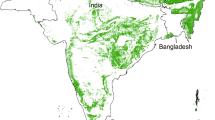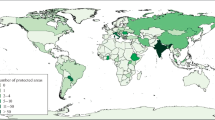Abstract
In recent years, the territory of Moscow has greatly increased in size, which led to a sharp decline in the biodiversity of many territories that were not part of Moscow before. Using remote sensing methods, the nature of vegetation and dynamics of land use in New Moscow for the 2014–2019 period were assessed in the article. Forests occupy about 42% of the territory of New Moscow, and cultural plantations account for about 28.5%. From 2014 to 2019, the area of residential sites increased by 8%, the area of meadows decreased by 7%, and that of forests—by 1%. The main areas for biodiversity conservation in New Moscow are specially protected natural areas (SPNAs). It is necessary to create an ecological frame of protected areas and monitor it by interpreting space images.
Access this chapter
Tax calculation will be finalised at checkout
Purchases are for personal use only
Similar content being viewed by others
References
Kavayas, F., Ramos, Y., & Boye, A. (2011). Inventory and monitoring of urban green spaces using WorldView-2 data. Geomatika. No. 3 (pp. 67–73).
Moscow City Government, Department of Natural Resources Management and Environmental Protection of Moscow. Moscow, 2015 Report “On State of Environment in Moscow in 2014” (pp. 385).
Stanis, E. V., Karpukhina, E. A., Makarova, M. G. (2015). Changes of new Moscow territory and preservation of natural heritage. In Geology, geoecology, evolutionary geography: Collective monograph. Volume 14, Saint Petersburg: Herzen University Publishing House, (pp. 258–262).
Stanis, E. V., Buldovich, N. S., Karpukhina, E. A., Makarova, M. G. (2016). Transformation of territorial structure of new territories of moscow and preservation of natural heritage. In Natural and cultural heritage: Interdisciplinary research, preservation and development, Saint Petersburg, Herzen University Publishing House, (pp. 563–566).
Stanis, E. V., Karpukhina, E. A. et al. (2012). Natural Ecosystems of Moscow Region (pp. 94). Publishing and Analysis Centre Energia.
Author information
Authors and Affiliations
Corresponding author
Editor information
Editors and Affiliations
Rights and permissions
Copyright information
© 2023 The Author(s), under exclusive license to Springer Nature Switzerland AG
About this paper
Cite this paper
Aleynikova, A.M., Karpukhina, E.V., Marsheva, N.V., Parakhina, E.A. (2023). Assessment of Moscow’s New Territory for Biodiversity Conservation Using Remote Sensing. In: Kallel, A., et al. Selected Studies in Environmental Geosciences and Hydrogeosciences. CAJG 2020. Advances in Science, Technology & Innovation. Springer, Cham. https://doi.org/10.1007/978-3-031-43803-5_13
Download citation
DOI: https://doi.org/10.1007/978-3-031-43803-5_13
Published:
Publisher Name: Springer, Cham
Print ISBN: 978-3-031-43802-8
Online ISBN: 978-3-031-43803-5
eBook Packages: Earth and Environmental ScienceEarth and Environmental Science (R0)




